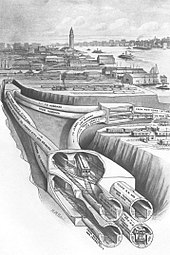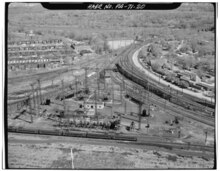This article needs additional citations for verification .(June 2011) |

A flying junction or flyover is a railway junction at which one or more diverging or converging tracks in a multiple-track route cross other tracks on the route by bridge to avoid conflict with other train movements. A more technical term is "grade-separated junction". A burrowing junction or dive-under occurs where the diverging line passes below the main line.
Contents
- Complexity
- Flying junction without crossings
- High-speed rail
- Examples
- See also
- Notes
- References
- External links
The alternative to grade separation is a level junction or flat junction, where tracks cross at grade, and conflicting routes must be protected by interlocked signals.





